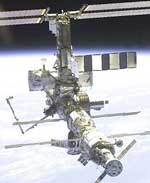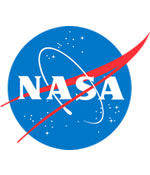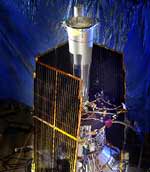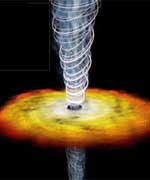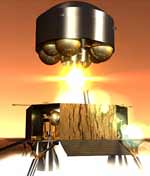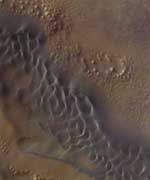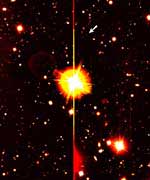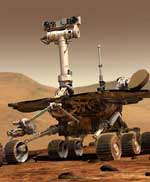
Image credit: NASA/JPL
In case you’d forgotten about them, NASA’s twin Mars Exploration spacecraft, Spirit and Opportunity, are still on their way to the Red Planet. Spirit made its third trajectory correction last week to fine-tune its flight path as it gets closer. Both rovers have rebooted their computers in the past two weeks to remove any data errors that could have caused by the recent powerful solar storms. Spirit should arrive at the Gusev Crater on January 4, 2004, while Opportunity will land Meridiani Planum on January 25.
NASA’s Spirit spacecraft made its third trajectory correction maneuver on Friday, Nov. 14, fine tuning its flight path toward Mars with an engine-firing operation planned into the seven-month trip.
The trajectory adjustment was designed to alter Spirit’s velocity by 0.6 meters per second (1.3 miles per hour), moving the arrival point by 770 kilometers (478 miles) and arrival time by 16.5 minutes closer to the planned target location and time, said Louis D’Amario, the project’s navigation team chief. To accomplish that adjustment, the flight team commanded Spirit to fire its engines for 132 seconds in the direction of the spacecraft’s rotation axis and for short pulses totaling 27 seconds in a direction roughly perpendicular to the rotation axis.
Spirit has three more scheduled dates for additional trajectory corrections before reaching Mars less than seven weeks from now. The spacecraft is carrying the first of two Mars Exploration Rovers equipped to examine the geology around their landing sites for evidence about past environmental conditions.
Both Spirit and its twin, Opportunity, have rebooted their computers in the past two weeks. Mission controllers at NASA’s Jet Propulsion Laboratory, Pasadena, Calif., sent commands for that procedure on each spacecraft to correct possible corruption of computer memory registers by radiation from powerful solar flares in late October and early November. The flares were among the most intense ever recorded.
“We had no evidence of memory problems, but we considered it prudent to reboot both spacecraft to assure memory integrity, using the sleep-wake cycle that we plan to do each night after the rovers are on the surface of Mars,” said JPL’s Peter Theisinger, project manager for the Mars Exploration Rover Project.
High-energy protons ejected by the stormy Sun appeared on Oct. 28 as bursts of bright spots in star-tracking instruments used by both Spirit and Opportunity to sense the spacecrafts’ orientation. The instruments interpreted the proton hits as stars, so the bursts overwhelmed their ability to recognize star patterns and determine spacecraft attitude. Both spacecraft temporarily switched to a backup method of attitude sensing, using the Sun. They resumed use of the star trackers last week.
Spirit’s target is arrival at Mars’ Gusev Crater at 04:35 Jan. 4, 2004, Universal Time (8:35 p.m. Jan. 3, Pacific Standard Time and 11:35 p.m. Jan. 3, Eastern Standard Time). These are “Earth received times,” meaning they reflect the delay necessary for a speed-of-light signal from Mars to reach Earth; on Mars, the landing will have happened nearly 10 minutes earlier. Three weeks later, at 05:05 Jan. 25, Universal Time, Opportunity will arrive at a level plain called Meridiani Planum on the opposite side of Mars from Gusev. Each rover will examine its landing area for geological evidence about the history of water there, key information for assessing whether the site ever could have been hospitable to life.
As of 6 a.m. PST on Nov. 19, Spirit had traveled 396.5 million kilometers (246.4 million miles) since its June 10 launch, with 91.5 million kilometers (56.2 million miles) to go before reaching Mars. Opportunity, launched on July 7, had traveled 326 million kilometers (202 million miles) and has 130 million kilometers (81 million miles) yet to go.
JPL, a division of the California Institute of Technology, manages the Mars Exploration Rover project for NASA’s Office of Space Science, Washington, D.C. Additional information about the project is available from JPL at http://mars.jpl.nasa.gov/mer and from Cornell University, Ithaca, N.Y., at http://athena.cornell.edu.
Original Source: NASA/JPL News Release

